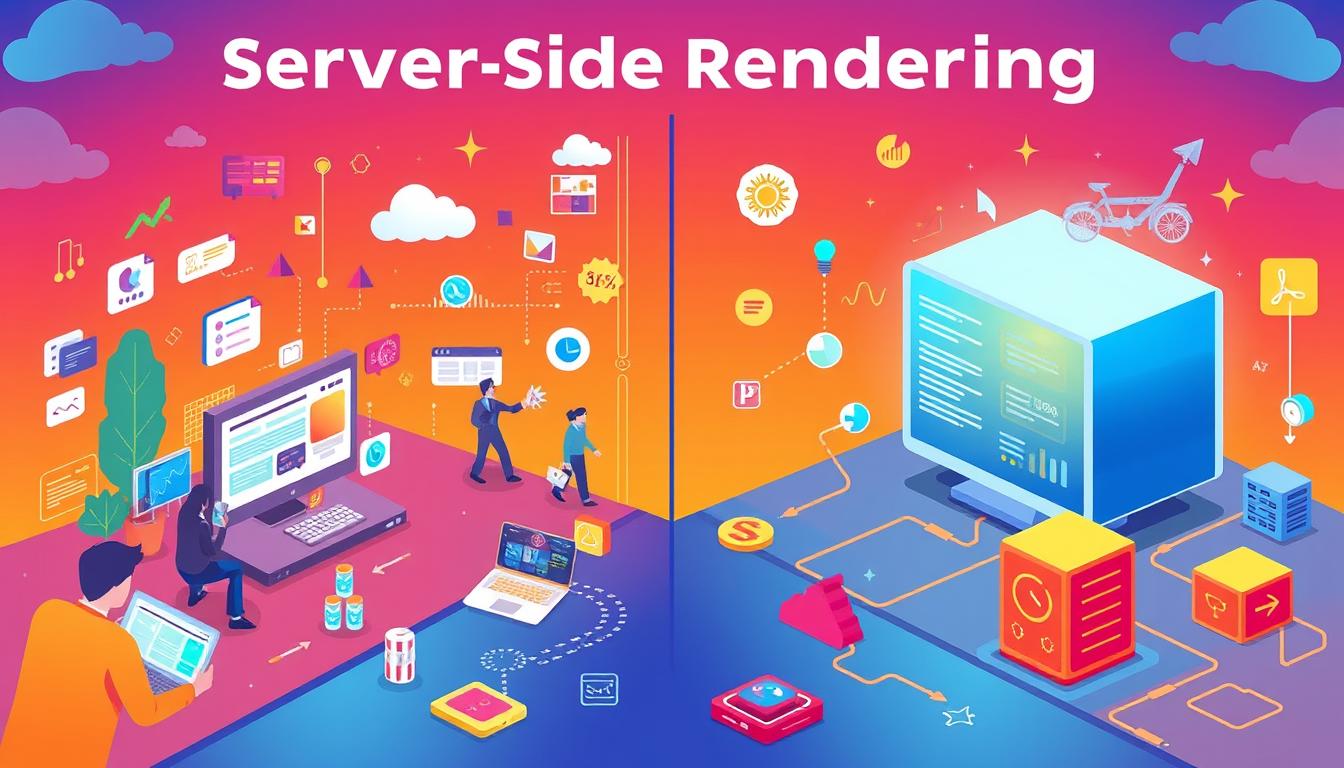Server-Side Rendering in Next.js: A Complete Guide
In the dynamic world of web development, the ability to efficiently render content on the server has become a crucial component in creating high-performance, user-friendly applications. Enter Next.js, a powerful React framework that has revolutionized the way developers approach Server-Side Rendering (SSR). This comprehensive guide will explore the intricacies of Server-Side Rendering in Next.js, equipping you with the knowledge and tools to master this fundamental technique and elevate your Next.js projects to new heights.
Key Takeaways
- Understand the core principles of Server-Side Rendering and its benefits for Next.js applications.
- Learn how to set up a Next.js project and leverage its built-in rendering methods.
- Discover the power of the
getServerSidePropsfunction for fetching data on the server. - Explore strategies for optimizing Server-Side Rendering, including code splitting and lazy loading.
- Gain insights into the differences between Server-Side Rendering and Static Site Generation in Next.js.
- Determine when to utilize Server-Side Rendering in your Next.js projects for maximum impact.
- Learn about deployment and hosting options for Server-Side Rendered Next.js applications.
Understanding Server-Side Rendering
In the dynamic world of web development, the concept of Server-Side Rendering (SSR) has gained significant traction. Server-Side Rendering is a rendering technique where the initial page load is generated on the server, and the fully rendered HTML is sent to the client. This approach can offer numerous benefits compared to traditional client-side rendering.
What is Server-Side Rendering?
Server-Side Rendering is a process where the web application’s UI is rendered on the server, and the complete HTML is then sent to the client’s browser. This contrasts with client-side rendering, where the application’s logic and rendering are handled by the client’s web browser. With SSR, the server does the heavy lifting, preparing the HTML before it reaches the user’s device, resulting in a faster initial load time and improved user experience.
Benefits of Server-Side Rendering
Implementing Server-Side Rendering in your web application can provide several advantages:
- Improved Performance: By rendering the initial page on the server, SSR can reduce the time it takes for the first page to load, as the client receives a complete, pre-rendered HTML document rather than having to wait for the JavaScript to load and render the page.
- Enhanced SEO: Search engines typically have an easier time indexing and understanding content that is rendered on the server, as they can directly access the HTML structure and content, leading to better search engine visibility and ranking.
- Better User Experience: With faster initial load times, users can engage with the content more quickly, resulting in a more seamless and enjoyable experience on your website or application.
Overall, Server-Side Rendering can be a powerful tool in your web development arsenal, offering a range of benefits that can improve performance, search engine optimization, and user experience.
Server-Side Rendering in Next.js
Next.js is a powerful React framework that simplifies the implementation of Server-Side Rendering (SSR). This section explores how Next.js handles Server-Side Rendering and the advantages it offers for building modern web applications.
With Next.js SSR, the initial page load is rendered on the server, ensuring faster load times and better search engine optimization (SEO). This is particularly beneficial for content-heavy websites, e-commerce platforms, and applications that require immediate data display.
One of the key benefits of Implementing SSR in Next.js is the ability to pre-render pages at build time, reducing the server load and improving the overall performance of your application. This approach also enables better handling of user interactions and state management, leading to a more responsive and engaging user experience.
Next.js provides a built-in getServerSideProps function that allows you to fetch data on the server and pass it to your components, ensuring that the initial render is powered by server-side data. This feature simplifies the process of Server-Side Rendering in Next.js, making it accessible to developers of all skill levels.
Overall, Server-Side Rendering in Next.js offers a powerful and efficient way to build modern web applications, combining the benefits of server-side rendering with the flexibility and developer experience of the React ecosystem.
Setting Up a Next.js Application
Before you can dive into the world of server-side rendering with Next.js, you’ll need to set up a new Next.js application. This process involves installing Next.js and creating a new project, which will serve as the foundation for the upcoming sections of this guide.
Installing Next.js
The first step is to install Next.js on your system. You can do this by using npm, the Node.js package manager. Open your terminal or command prompt and run the following command:
npm install next react react-domThis will install the necessary packages for your Next.js application, including the core Next.js library, React, and React DOM.
Creating a New Project
After installing Next.js, you can create a new project by running the following command in your terminal:
npx create-next-app my-next-appThis will create a new Next.js project called “my-next-app” in your current directory. You can replace “my-next-app” with the name of your choice for your project.
Once the project is created, you can navigate to the project directory and start the development server:
cd my-next-app
npm run devThis will start the Next.js development server, and you can access your application by opening a web browser and navigating to http://localhost:3000.
Congratulations! You’ve successfully set up a new Next.js application, laying the groundwork for exploring server-side rendering in the upcoming sections.
Rendering Methods in Next.js
Next.js, the popular React framework, offers a range of rendering methods to meet the diverse needs of web applications. These rendering approaches include Server-Side Rendering (SSR), Client-Side Rendering (CSR), and Static Site Generation (SSG). Understanding the strengths and use cases of each method is crucial in building efficient and user-friendly Next.js applications.
Server-Side Rendering (SSR) in Next.js
In Server-Side Rendering, the initial page load is generated on the server, ensuring faster initial load times and better SEO performance. This approach is particularly useful for content-heavy websites, dynamic pages, and applications that require server-side data processing.
Client-Side Rendering (CSR) in Next.js
Client-Side Rendering in Next.js shifts the rendering process to the client, allowing for a more interactive and dynamic user experience. This method is well-suited for applications that prioritize responsiveness and feature-rich user interfaces, such as single-page applications (SPAs) and highly interactive web applications.
Static Site Generation (SSG) in Next.js
Static Site Generation is a powerful rendering method in Next.js, where the pages are pre-rendered at build time and served as static HTML files. This approach offers lightning-fast load times, excellent SEO, and reduced server-side processing, making it a great choice for content-driven websites and blogs.
By understanding the Next.js Rendering Methods, developers can make informed decisions about which approach best fits their project’s requirements, ultimately leading to more efficient and high-performing web applications.
Server-Side Rendering in Next.js: A Complete Guide
Delving into the world of Complete Guide to Server-Side Rendering in Next.js, we’ll explore the intricacies of Implementing SSR in Next.js and discover the benefits of Using SSR in Next.js. This comprehensive guide will equip you with the knowledge to seamlessly integrate server-side rendering into your Next.js projects, elevating your web applications to new heights.
Server-side rendering (SSR) in Next.js is a powerful feature that allows your application to be rendered on the server, providing several advantages over traditional client-side rendering. From improved SEO and faster initial load times to enhanced user experience, SSR is a game-changer for Next.js developers.
To get started, you’ll need to set up a Next.js application and familiarize yourself with the different rendering methods available. Once you have a solid understanding of the underlying concepts, you can dive into the specifics of Implementing SSR in Next.js and Using SSR in Next.js.
One of the key aspects of server-side rendering in Next.js is data fetching. Using the getServerSideProps function, you can fetch data on the server and pass it down to your components, ensuring a seamless and performant user experience.
To further optimize your server-side rendered application, you’ll learn about code splitting and lazy loading, two powerful techniques that can dramatically improve your application’s performance.
Throughout this comprehensive guide, you’ll gain a deep understanding of the benefits and best practices for Complete Guide to Server-Side Rendering in Next.js. Whether you’re a seasoned Next.js developer or just starting out, this guide will equip you with the knowledge and tools to harness the power of server-side rendering and take your web applications to new heights.
“Server-side rendering is a game-changer for Next.js developers, unlocking a world of possibilities for building high-performance, SEO-friendly web applications.”
Data Fetching with getServerSideProps
One of the standout features of Next.js is its powerful `getServerSideProps` function, which enables developers to fetch data on the server-side and seamlessly pass it to their React components. This approach is particularly beneficial for improving the overall user experience, as it ensures that critical data is available to the client immediately upon page load.
Fetching Data on the Server
The `getServerSideProps` function is a Next.js-specific feature that runs on the server before the page is rendered. This allows you to fetch data from external sources, such as APIs or databases, and make it available to your components. By performing this data-fetching step on the server, you can avoid the need for additional client-side network requests, leading to faster page loads and a more responsive user interface.
Passing Data to Components
Once the data has been fetched using `getServerSideProps`, it can be passed directly to your React components as props. This makes the data easily accessible and ready for rendering, without the need for additional client-side data-fetching logic. This approach not only simplifies your component structure but also enhances the overall performance of your Next.js application.
| Benefit | Description |
|---|---|
| Improved Performance | By fetching data on the server and passing it to components, you can reduce the number of client-side network requests, leading to faster page loads and a more responsive user experience. |
| Simplified Components | With data already available as props, your components can focus on rendering the UI rather than handling complex data-fetching logic. |
| Enhanced SEO | Server-side rendering ensures that search engines can easily crawl and index the content of your pages, improving their visibility in search results. |
In the next section, we’ll explore how to optimize your server-side rendering process and take full advantage of the power of `getServerSideProps` in your Next.js applications.
Optimizing Server-Side Rendering
While server-side rendering (SSR) in Next.js offers numerous benefits, such as improved search engine optimization and faster initial page load times, it’s crucial to optimize your implementation to ensure maximum performance. In this section, we’ll explore two powerful techniques – code splitting and lazy loading – that can help you deliver a fast and responsive user experience even with server-side rendering.
Code Splitting in Next.js
One of the key strategies for optimizing server-side rendering in Next.js is code splitting. This involves dividing your application’s JavaScript code into smaller, more manageable chunks, which can then be loaded on-demand as the user navigates your site. By reducing the initial bundle size, code splitting helps minimize the time it takes for your pages to render, especially on slow or unstable connections.
Next.js makes code splitting easy with its built-in support for dynamic imports. You can use the dynamic() function to lazy-load components or modules, ensuring that only the necessary code is downloaded and executed.
Lazy Loading in Next.js
Closely related to code splitting, lazy loading is another powerful optimization technique for server-side rendering in Next.js. Lazy loading involves deferring the loading of non-critical resources, such as images or third-party scripts, until they are actually needed by the user. This helps reduce the initial payload size and improves the perceived performance of your application.
In Next.js, you can leverage the next/image component to implement lazy loading for images. This component automatically optimizes image loading and provides advanced features like responsive image sizing and format optimization.
By combining code splitting and lazy loading, you can create a highly optimized server-side rendered application in Next.js, delivering a fast and responsive user experience that meets the expectations of modern web users.
Server-Side Rendering vs. Static Site Generation
When it comes to building web applications with Next.js, developers have two primary rendering options: Server-Side Rendering (SSR) and Static Site Generation (SSG). Understanding the differences between these approaches is crucial when Choosing Between SSR and SSG for your Next.js project.
Server-Side Rendering (SSR) is a technique where the initial page load is generated on the server before being sent to the client. This approach offers several advantages, such as improved SEO and faster initial load times, as the entire page is pre-rendered on the server. However, SSR can also result in higher server-side processing requirements, which can impact scalability and performance for highly dynamic applications.
On the other hand, Static Site Generation (SSG) is a process where the pages are pre-rendered at build-time and served as static HTML files. This approach offers enhanced performance, as the static files can be efficiently cached and served directly by a Content Delivery Network (CDN). SSG is particularly well-suited for content-heavy websites or blogs, where the content doesn’t change frequently.
| Comparison | Server-Side Rendering (SSR) | Static Site Generation (SSG) |
|---|---|---|
| Initial Load Time | Faster | Faster |
| SEO | Better | Better |
| Scalability | Less Scalable | More Scalable |
| Dynamic Content | Better | Less Suitable |
When Comparing SSR and SSG in Next.js, the choice between the two ultimately depends on the specific requirements of your application. If your website or web app requires frequent updates, dynamic content, or complex server-side logic, then Server-Side Rendering may be the better option. However, if you’re building a content-heavy website with relatively static content, Static Site Generation can provide a more performant and scalable solution.
“The choice between Server-Side Rendering and Static Site Generation in Next.js should be based on the specific needs of your application, balancing performance, scalability, and dynamic content requirements.”
When to Use Server-Side Rendering
Server-Side Rendering (SSR) in Next.js is a powerful tool, but it’s not always the best choice for every web application. In this section, we’ll explore the specific use cases and scenarios where SSR can be particularly beneficial, helping you determine when to leverage this rendering technique in your projects.
When to Use Server-Side Rendering in Next.js
- Improved SEO: If your website’s content is heavily dependent on search engine optimization (SEO), SSR can be immensely beneficial. With SSR, the entire page is rendered on the server, allowing search engine bots to easily crawl and index your content.
- Fast Initial Load Times: SSR can provide a faster initial load time for your web application, as the server handles the rendering and sends the fully rendered HTML to the client. This is particularly useful for websites that prioritize perceived performance and want to provide a snappy user experience.
- Dynamic Content: If your web application deals with frequently changing or dynamic content, such as news articles, blog posts, or e-commerce product listings, SSR can be the optimal choice. This ensures that users always see the most up-to-date information when they visit your site.
Use Cases for SSR in Next.js
- News and Media Websites: SSR is particularly well-suited for news and media websites, where the content is constantly updated and needs to be quickly accessible to users.
- E-commerce Platforms: SSR can enhance the user experience on e-commerce platforms by providing fast initial load times and ensuring that product information is always up-to-date.
- Enterprise-level Applications: Large-scale enterprise applications with complex data requirements often benefit from the server-side rendering capabilities of Next.js, as it can handle the initial data fetching and rendering efficiently.
Scenarios Where SSR is Beneficial
| Scenario | Benefit of SSR |
|---|---|
| Time-sensitive Content | Ensures users see the latest information without delays. |
| High-Traffic Websites | Distributes the rendering load to the server, improving overall performance. |
| Complex Data Visualizations | Allows for efficient server-side data processing and rendering. |
By understanding these use cases and scenarios, you can make an informed decision on when to leverage the benefits of Server-Side Rendering in your Next.js applications, ultimately delivering a better user experience and improving the overall performance of your web projects.
Deployment and Hosting
Once you’ve mastered the art of implementing Server-Side Rendering (SSR) in your Next.js applications, the next crucial step is to ensure seamless deployment and hosting. In this section, we’ll explore the process of deploying Next.js applications with SSR to the popular platform, Vercel, as well as other deployment options.
Deploying to Vercel
Vercel, the company behind Next.js, offers a robust and streamlined platform for hosting Next.js applications with SSR. The deployment process is straightforward and user-friendly, making it an excellent choice for both experienced developers and those new to the Next.js ecosystem.
- Create a Vercel account or log in to your existing one.
- Connect your Next.js project’s repository to Vercel.
- Configure your project’s settings, including the build command, output directory, and environment variables.
- Deploy your application, and Vercel will handle the rest, ensuring your Next.js application with SSR is live and accessible to your users.
Deploying to Other Platforms
While Vercel is a popular choice for hosting Next.js applications with SSR, there are other platforms that also support the deployment of Next.js applications with SSR. These include:
- AWS Amplify
- Netlify
- DigitalOcean
- Heroku
Each platform offers its unique features and capabilities, so it’s essential to research and evaluate the options to determine the best fit for your Next.js application with SSR and your specific deployment requirements.
“Deploying your Next.js application with SSR is a critical step in bringing your project to life. Vercel makes it seamless, while other platforms offer flexibility to suit your unique needs.”
Whether you choose to deploy your Next.js application with SSR on Vercel or another platform, the key is to ensure a smooth and reliable deployment process that delivers an exceptional user experience for your audience.
Conclusion
As we conclude our comprehensive guide on Server-Side Rendering (SSR) in Next.js, it’s clear that this powerful feature is a game-changer for developers seeking to build exceptional web applications. By leveraging the benefits of SSR, you can create high-performance, SEO-friendly, and user-centric experiences that captivate your audience in Indonesia.
Throughout this guide, we’ve explored the fundamentals of SSR, delved into its implementation within the Next.js framework, and discussed strategies for optimizing your server-side rendered applications. From understanding the core concepts to mastering data fetching and deployment, you now possess the knowledge to harness the full potential of Next.js’s SSR capabilities.
The Summary of Next.js SSR Guide is clear: by embracing SSR, you can unlock a new level of performance, search engine visibility, and user engagement for your web projects. Whether you’re building a dynamic e-commerce platform, a content-rich media website, or a data-driven web application, the principles and techniques covered in this guide will empower you to create exceptional experiences that captivate your audience in Indonesia.
FAQ
What is Server-Side Rendering (SSR) in Next.js?
Server-Side Rendering (SSR) in Next.js is a rendering technique where the initial page load is generated on the server, and the fully rendered HTML is sent to the client. This approach can improve performance, SEO, and user experience compared to traditional client-side rendering.
What are the benefits of using Server-Side Rendering in Next.js?
Some of the key benefits of using Server-Side Rendering in Next.js include improved performance, better search engine optimization (SEO), enhanced user experience, and easier initial page load. SSR can also help with rendering dynamic content and improving accessibility.
How do I set up a new Next.js application with Server-Side Rendering?
To set up a new Next.js application with Server-Side Rendering, you’ll need to install the Next.js framework and create a new project. This typically involves running a few commands in your terminal and setting up the necessary configuration files.
What are the different rendering methods available in Next.js?
Next.js offers several rendering methods, including Server-Side Rendering (SSR), Client-Side Rendering (CSR), and Static Site Generation (SSG). The choice of rendering method depends on the specific requirements of your application, such as the need for dynamic content, SEO, and performance.
How do I implement Server-Side Rendering in a Next.js application?
To implement Server-Side Rendering in a Next.js application, you’ll need to use the `getServerSideProps` function. This function allows you to fetch data on the server and pass it to your React components, ensuring that the initial page load is rendered on the server.
How can I optimize the performance of a Server-Side Rendered Next.js application?
To optimize the performance of a Server-Side Rendered Next.js application, you can leverage techniques like code splitting and lazy loading. These approaches can help reduce the initial page load time and deliver a faster user experience.
When should I choose Server-Side Rendering over Static Site Generation in Next.js?
The choice between Server-Side Rendering and Static Site Generation in Next.js depends watitoto on the specific requirements of your application. SSR is generally better suited for dynamic, frequently updated content, while SSG is more suitable for static, content-heavy websites. Consider factors like performance, SEO, and the need for real-time data to determine the best rendering method for your project.
How do I deploy a Next.js application with Server-Side Rendering?
Deploying a Next.js application with Server-Side Rendering is typically straightforward. You can use a hosting platform like Vercel, which is specifically designed for deploying Next.js applications, or other popular cloud hosting services like AWS, Google Cloud, or DigitalOcean.













